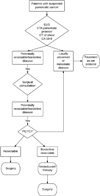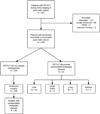PET/CT Fusion Scan Prevents Futile Laparotomy in Early Stage Pancreatic Cancer
- PMID: 26053713
- PMCID: PMC4813735
- DOI: 10.1097/RLU.0000000000000837
PET/CT Fusion Scan Prevents Futile Laparotomy in Early Stage Pancreatic Cancer
Abstract
Background: Surgical resection with negative margins is the only curative approach for pancreatic cancer. A paucity of data exists in using PET/CT scan as staging workup in resectable pancreatic cancer. The aim of this study is to determine if PET/CT prevents futile laparotomy by detecting occult metastatic disease in patients with resectable or borderline resectable pancreatic cancer.
Methods: Patients were included using institutional PET/CT data base incorporating National Oncologic PET Registry with diagnosis of resectable or borderline resectable pancreatic cancer from 2005 to 2012. Clinical, radiographic, and pathologic characteristics were evaluated. The impact of PET/CT on patient management was estimated by calculating the percentage of patients whose treatment plan was altered secondary to PET/CT.
Results: We identified 285 patients with early stage pancreatic cancer who received PET/CT as part of initial staging workup. Upon initial workup (CT + EUS), 62% of patients were considered resectable, and 38% were borderline resectable. Addition of PET/CT scan changed the management in 10.9% (n = 31) of the patients (95% CI, 8%-15%). Metastatic lesions were confirmed with biopsy in 19 patients (61%). The proportion of change in treatment plan was significantly higher in patients who were initially considered to have borderline resectable compared with resectable malignancy (17% vs 7%, P = 0.019). In 199 patients who underwent surgery, 18.1% (n = 36) were found to have metastatic disease intraoperatively.
Conclusions: PET/CT helped improve detection of occult metastases, ultimately sparing these patients a potentially unnecessary surgery. The role of PET/CT scan should be validated in prospective study.
Figures
Similar articles
-
Impact of F18-fluorodeoxyglycose positron emission tomography/computed tomography on the management of resectable pancreatic tumours.ANZ J Surg. 2012 Mar;82(3):140-4. doi: 10.1111/j.1445-2197.2011.05972.x. Epub 2012 Jan 17. ANZ J Surg. 2012. PMID: 22510123
-
The value of positron emission tomography/computed tomography for evaluating metastatic disease in patients with pancreatic cancer.Pancreas. 2012 Aug;41(6):897-903. doi: 10.1097/MPA.0b013e318252f4f5. Pancreas. 2012. PMID: 22699202
-
PET/CT fusion scan enhances CT staging in patients with pancreatic neoplasms.Ann Surg Oncol. 2008 Sep;15(9):2465-71. doi: 10.1245/s10434-008-9992-0. Epub 2008 Jun 13. Ann Surg Oncol. 2008. PMID: 18551347
-
Pretherapeutic evaluation of patients with upper gastrointestinal tract cancer using endoscopic and laparoscopic ultrasonography.Dan Med J. 2012 Dec;59(12):B4568. Dan Med J. 2012. PMID: 23290296 Review.
-
PET/CT of cancer patients: part 1, pancreatic neoplasms.AJR Am J Roentgenol. 2012 Nov;199(5):952-67. doi: 10.2214/AJR.11.8182. AJR Am J Roentgenol. 2012. PMID: 23096166 Review.
Cited by
-
Preoperative assessment of pancreatic cancer with [68Ga]Ga-DOTA-FAPI-04 PET/MR versus [18F]-FDG PET/CT plus contrast-enhanced CT: a prospective preliminary study.Eur J Nucl Med Mol Imaging. 2025 Feb;52(3):1017-1027. doi: 10.1007/s00259-024-06943-z. Epub 2024 Nov 7. Eur J Nucl Med Mol Imaging. 2025. PMID: 39508900 Clinical Trial.
-
CA19.9 Serum Level Predicts Lymph-Nodes Status in Resectable Pancreatic Ductal Adenocarcinoma: A Retrospective Single-Center Analysis.Front Oncol. 2021 May 27;11:690580. doi: 10.3389/fonc.2021.690580. eCollection 2021. Front Oncol. 2021. PMID: 34123859 Free PMC article.
-
Unresolved endoplasmic reticulum stress engenders immune-resistant, latent pancreatic cancer metastases.Science. 2018 Jun 15;360(6394):eaao4908. doi: 10.1126/science.aao4908. Epub 2018 May 17. Science. 2018. PMID: 29773669 Free PMC article.
-
The Role of Positron Emission Tomography/Computed Tomography (PET/CT) for Staging and Disease Response Assessment in Localized and Locally Advanced Pancreatic Cancer.Cancers (Basel). 2021 Aug 18;13(16):4155. doi: 10.3390/cancers13164155. Cancers (Basel). 2021. PMID: 34439307 Free PMC article. Review.
-
Use of imaging as staging and surgical planning for pancreatic surgery.Hepatobiliary Surg Nutr. 2020 Oct;9(5):603-614. doi: 10.21037/hbsn.2019.05.04. Hepatobiliary Surg Nutr. 2020. PMID: 33163511 Free PMC article. Review.
References
-
- Siegel R, Ma J, Zou Z, et al. Cancer statistics, 2014. CA: a cancer journal for clinicians. 2014;64:9–29. - PubMed
-
- Zamboni GA, Kruskal JB, Vollmer CM, et al. Pancreatic adenocarcinoma: value of multidetector CT angiography in preoperative evaluation. Radiology. 2007;245:770–778. - PubMed
-
- NCCN. NCCN Clinical Practice Guidelines in Oncology. Pancreatic cancer. Version 2.2012. http://www.nccn.org.
-
- Zimny M, Buell U. 18FDG-positron emission tomography in pancreatic cancer. Ann Oncol. 1999;10(Suppl 4):28–32. - PubMed
-
- Frohlich A, Diederichs CG, Staib L, et al. Detection of liver metastases from pancreatic cancer using FDG PET. Journal of Nuclear Medicine. 1999;40:250–255. - PubMed





